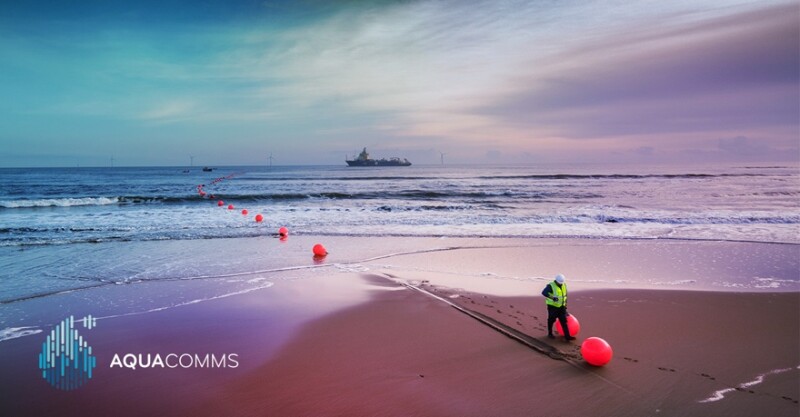
Developments in the era of cloud and digitisation have changed the shape of the subsea wholesale sector and even blurred definitions between what wholesale and enterprise mean. Chris Bayly, CCO at Aqua Comms, reflects on these dynamics and their significance both historically and into the future.
What is Wholesale? And what is meant by Enterprise? This may all seem obvious, with the two usually considered as clearly defined segments by the telecoms sector. But if we look deeper into how the market has evolved, is it time to revisit and maybe even redefine what we mean by Wholesale and Enterprise?
In the age of digitisation, the rise of massive-scale OTT players and the cloud, the picture is more… well… cloudy – with many players that would have traditionally been viewed as enterprises buying wholesale services in a way that they didn’t before.
Getting a grip on what comprises today’s wholesale and enterprise worlds may be key for wholesale operators, helping define their own role in the market to aid in mapping out their future route for targeting customers.
Taking a step back first, what is clear is that we are in the midst of a fourth industrial revolution, which the World Economic Forum (WEF) defines as a period that “represents a fundamental change in the way we live, work and relate to one another. It is a new chapter in human development, enabled by extraordinary technology advances commensurate with those of the first, second and third industrial revolutions.”
Living at this fast-moving time comes with uncertainties: we’re unclear where it will go or where it will end, but to be classified as a revolution, it means that what we have, what we know and what we think could all change. This will potentially be so significant that we need to relook at everything that we once took for granted.
The meaning behind “extraordinary technology advances” in the WEF description becomes particularly clear when I look at what technologies my children have available to them and reflect on how much things have changed since I was growing up. I didn’t grow up with a mobile phone, let alone social media or on-demand TV, and the internet was a not a consumer-available network.
Changes afoot
In my 30 years or so in the telecoms industry, we have seen the introduction of email at work, initially connecting to an on-site mainframe computer in the office from a desktop PC.
I even clearly remember the excitement and feeling of wonderment at having caller line identification (CLI) on my internal desk phone. We saw the first uses of digital technology, and while 30 years may seem a long time, the extent to which technology has evolved over that time is astonishing.
In an interview with Wired as far back as 1996, Steve Jobs’ insight into his use of IT painted an eerily accurate picture of how our cloud-based world has turned out today: “I don’t store anything any more, really. I use a lot of email and the web, and with both of those I don’t have to ever manage storage… It’s much like the old mainframe computing environment, where a web browser is like a dumb terminal and the web server is the mainframe where all the processing’s done.”
We therefore saw the proliferation of mainframe computer deployment in the 1980s to 1990s, followed by a transition to storage on individual devices and the mass rollout of PCs, laptops, mobile phones and other technology.
Now it has come full circle back to a more mainframe-type environment, amid the rise of cloud and the digitalisation of enterprises everywhere. So those very devices we all bought and still buy don’t hold any data – instead, it is held in the cloud. We have smartphones not to store data, but to access it wherever we are and whatever we are doing.
Wholesale? Or Enterprise?
This takes us on to what it all means for the telecoms environment and the established definitions of Wholesale and Enterprise. But before we debate this, let’s take a quick look at the simple dictionary definition of Wholesale: “The business of selling of goods in large quantities and at low prices, typically to be sold on by retailers at a profit.”
Now looking at the sector of the industry I operate in – selling capacity-based services in the subsea cable business – this has always focused on carriers and ISPs, plus Research and Education Networks, as Wholesale.
Then along came the OTTs, and it has always been a bit unclear where they fit – are they Enterprise? Are they Wholesale? Or do they deserve a unique category of their own?
Most organisations started out wanting to treat OTTs as belonging to the enterprise segment – in part because they started out with relatively modest needs compared to today, and possibly also to recognise enterprise-level revenue that was deemed more valuable by industry analysts.
Yet in reality, OTTs buy like wholesalers. They certainly buy in volume to the point where now some OTTs build new cables, such is the enormity of their needs.
However, in the new world of Wholesale, there is an important distinction: they don’t sell the capacity to make their profit. The capacity, which forms the backbone of their network, is needed for their services to work and they don’t typically charge the consumer to use it. Facebook is free; Google Search is free.
Tech revolution
The emergence of the OTTs was the start of a technology revolution for the subsea cable industry – and while we understand this sector better today, it’s still relatively new. To give this some context, Facebook (now Meta) was founded in 2004, making it 18 years old, and is believed to be easily the largest user of subsea capacity in the world.
This was the start of how Wholesale, in my view, has quickly moved to now being a bigger, wider sector. Think of the more recent companies that are now household names offering free services, such as Zoom.
This is not, however, the only area where I feel Wholesale has changed and, in fact, widened. When looking at the digitalisation of businesses, a key foundation for this is the establishment of the cloud and what this means for network usage, design and management.
It goes back to Steve Jobs’ comments on devices not storing data, but working via a connection similar to the mainframe computer environment. Today, this happens to be the cloud, a network that relies on a high-bandwidth backbone linked up to data centres around the world.
We are now seeing more and more of what we call ‘new tech’ companies: firms that buy the same megabits and gigabits that carriers, incumbents and others buy but don’t then sell them like a carrier to make a profit. Their service is different, yet still needs the network.
Organisations such as banks – traditionally considered enterprises – are starting to buy and operate private networks for some of their needs. This set-up comprises an ‘enterprise’ buying what was traditionally a wholesale service, managed by an internal network team experienced in buying and managing a private network.
It does not, therefore, rely on an off-the-shelf telco service that comes with features such as a dedicated service manager and enterprise-class SLAs: it’s a team that knows how wholesale services work and manages them accordingly with its suppliers.
Move to digitalisation
This current aggressive move to digitalised business models and managing these private networks via the cloud – typically using a combination of public and private cloud services – means that, increasingly, what are deemed enterprises are buying wholesale services to run their businesses. They are not doing this as a telco or carrier, but simply to operate the same business they have always been in.
In summary, this current industrial revolution has redefined how we should look at Wholesale and Enterprise – not by the type of company or industry vertical, but simply by the services they buy.
This makes the wholesale market at the heart of the revolution, at the heart of the cloud and, ultimately, at the heart of every business. For the subsea cable business, which carries 99% of all international data, we are ready to support every enterprise – whether with a big ‘E’ or a small ‘e’.





